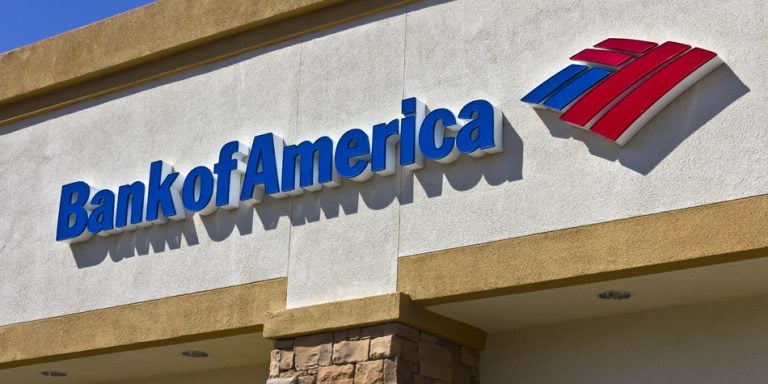Like most other big banks, Bank of America (NYSE:BAC) started 2018 with great anticipation. Last year was a surprisingly good one for BAC stock, gaining almost 33%. Fears that a Trump presidency would negatively impact the economy were unfounded, leading to equally successful share-price rallies for JPMorgan Chase (NYSE:JPM) and Citigroup (NYSE:C).
Perhaps the biggest exclamation point regarding the robustness in the financial sector was Wells Fargo (NYSE:WFC). Despite suffering ignominious scandals where the company admitted creating fake customer accounts, WFC managed to return 12% in 2017. True, the ride wasn’t smooth by any stretch of the imagination, but it highlighted a significant point — so strong were financial services that investors were willing to overlook egregious fraud.
My how things change in a year! Although BAC stock started off this year with a bang, sparked by an almost 8% move in January, it appears intent on ending it with a whimper. Since the beginning of February, shares are down 9%. Year-to-date, the BofA hopeful are staring at losses exceeding 2%.
What happened? Unemployment has dropped to multi-year record lows, providing people with more money in their pockets. Also, interest rates, while sharply rising from their recent lows, are not anywhere near nosebleed-inducing levels. The core ingredients for bank growth are evident, yet BAC stock remains muted.
I’ve argued that one of the headwinds is our perception of the economy. Simply put, we may not be as strong and stable as we would like to think. In this situation, Bank of America can’t take anything for granted. That’s why I blasted the organization for refusing to serve firearms-related businesses.
Subsequently, BAC stock is down 4.5% since my article was published. But now, I’m concerned that this volatility is just the beginning.
BAC Stock Is a Paper Tiger
Most analysts loved BofA’s first-quarter fiscal 2018 earnings performance, in which the banking giant delivered over $6.9 billion in profit. Not only was that up nearly 30% against the year-ago quarter, it was the biggest quarterly profit in company history.
But look a little deeper, and the numbers don’t add up to a confident posture for BAC stock. Primarily, Bank of America, along with its peers, benefitted handsomely from the so-called Trump tax cut. Thanks to the new changes, the corporate tax dropped from 35% to 21%. That move has allowed several blue chips to save billions.
Taking away this one-off occurrence, investors discover a different tale. I’m especially concerned about non-interest income, or the portion of sales not attributed to the financial assets that BofA owns. Non-interest income includes components like advisory services, consultations, and most importantly, lending.
While total revenue in Q1 2018 increased 3.9% year-over-year, non-interest income gained 2.9%. In contrast, net-interest income gained almost 5%. The situation becomes worse when you broaden the timeframe. Between 2014 and 2017, net-interest income gained 9.5%. Non-interest income actually decreased 5.4%.
So yes, you can make the argument that BAC stock is recovering due to strong financial performances. But those performances are based on the assets on BofA’s books, or more bluntly, the assets that the government gave in bailing out the previously troubled bank.
But where are the folks borrowing from BofA to buy a home, or to start a business venture? While they certainly exist, they’re not coming out in droves. Otherwise, we’d see Bank of America increase its lending activities, not decline year-to-year.
Worryingly, I don’t think the broader situation will improve. Real-estate markets are skyrocketing everywhere, pricing out the little guys.
BofA Is a Self-Serving Institution
And speaking of pricing-out the little guys, I must bring up the issue of equity buybacks. On paper, we’re seeing strong earnings per share growth. But as I explained earlier, that’s not due to direct business activities. Instead, the catalyst is white-collar tricks via share buybacks and cost-cutting efforts.
At this particular time, I agree with the criticism that BofA buying back its stock widens class disparity. The move benefits shareholders, but doesn’t do anything for workers. It’s not the most productive use of resources. At the very least, management should consider raising its dividend yield and de-prioritize the buybacks.
Because here’s the thing: this tactic is advantageous if BAC stock is undervalued. But I can make the case that BAC is instead overvalued. It’s not the growth that investors should focus on — rather, it’s context. If business activities aren’t driving revenues, but rather accounting gymnastics, how is BofA undervalued?
I see a situation where underlying economic pressures weigh down BAC stock. If that’s the case, the buybacks are occurring at a premium rate, not a discount. Again, that might serve shareholder interests in the nearer-term, but nobody else benefits.
As of this writing, Josh Enomoto did not hold a position in any of the aforementioned securities.

